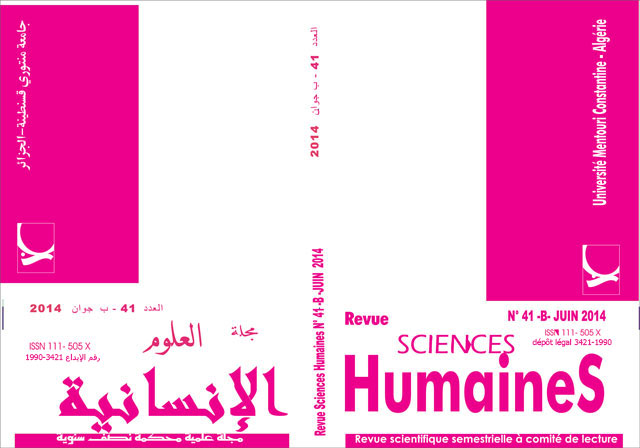Drawing the Profile of Students of English as Dictionary Users
الملخص
Fifty freshmen students of English took part in a study in order to establish their profile as dictionary users. The respondents completed a questionnaire regarding the types of dictionaries they used, the frequency of use, the main reasons for consultation, the difficulties in the lookup process, instruction in dictionary use, etc. The analysis of data revealed that the students use monolingual dictionaries (MLDs) more frequently than bilingual dictionaries (BLDs), and that the difficulties they have in the lookup process are due to deficiencies in their dictionaries. In addition, the results provide evidence that our students do not take full advantage of their monolingual dictionaries because they hardly make use of the appendices and usage guides in them. The findings also indicate that their dictionary skills are more or less weak. Therefore, this study suggests that our students should receive more training in dictionary use so that they enhance their skills and make the most of their dictionaries.التنزيلات
المراجع
-Songhao, L. (1997). Dictionary use as a way of learning vocabulary in SLA: A preliminary study. Journal of Educational Studies, 19(1), 82-99.
-Hartmann, R. R. (1999a). What is 'dictionary research?' [Review of the book Worterbuchforschung, by H. E. Wiegand]. International Journal of Lexicography, 12(2), 155-161.
-Stein, G. (1984). The English dictionary: past, present and future. Special lecture given on the occasion of the inauguration of the Dictionary Research Centre. Exeter: University of Exeter.
-Hartmann, R. R. (1999b). [Thematic report 2] Case study: The Exeter University survey of dictionary use. In R. K. Hartmann (Ed.), Dictionaries in language learning. recommendations, national reports and thematic reports from the TNP Sub-Project 9: Dictionaries (pp. 36-52). Retrieved from www.fu-berlin.de/elc/TNPproducts/SP9dossier.doc
-Diab, T. A., & Hamdan, J. M. (1999). Interacting with words and dictionaries: The case of Jordanian EFL learners. International Journal of Lexicography, 12(4), 281-305.
-Hartmann, R. R. (Ed.). (2003). Lexicography: Critical concepts. Routledge.
-Tomaszczyk, J. (1979). Dictionaries: Users and uses. Glottodidactica, 12, 103-119.
-Nesi, H. (2000). The use and abuse of EFL dictionaries: How learners of English as a foreign language read and interpret dictionary entries. Tübingen: Max Niemeyer Verlag.
-Lew, R. (2000). Questionnaires in dictionary use research: A reexamination. In A. Braasch, & C. Povlsen (Ed.), Proceedings of the 10th EURALEX International Congress.1, pp. 267-271. Copenhagen: Center for Sprogteknologi, Copenhagen University.
-Baxter, J. (1980). The dictionary and vocabulary behavior: A single word or a handful? TESOL Quarterly, 14(3), 325-336.
-Stein, G. (1990). From the bilingual to the monolingual dictionary. In T. Magay, & J. Zigany (Ed.), BudaLEX '88 Proceedings: Papers from the 3rd EURALEX International Congress (pp. 401-407). Budapest: Akademiai Kiado.
-Piotrowski, T. (1989). Monolingual and bilingual dictionaries: fundamental differences. In M. Tickoo (Ed.), Learners' dictionaries: State of the art (pp. 72-83). Singapore: SEAMEO Regional Language Centre.
-Bogaards, P. (1996). Dictionaries for Learners of English. International Journal of Lexicography, 9(4), 277-320.
-Cowie, A. P. (1999). English dictionaries for foreign learners: A history. Oxford: Oxford University Press.
-Tomaszczyk, J. (1983). On bilingual dictionaries: The case for bilingual dictionaries for foreign language learners. In R. Hartmann (Ed.), Lexicography: Principles and practice (pp. 41-51). London: Academic Press.
-Hanks, P. (1987). Definitions and explanations. In J. Sinclair (Ed.), Looking up: An account of the COBUILD Project in lexical computing and the development of the Collins COBUILD English language dictionary (pp. 116-136). London: Collins EL T.
-Neubach, A., & Cohen, A. D. (1988). Processing strategies and problems encountered in the use of dictionaries. Dictionaries: The Journal of the Dictionary Society of North America, 10, 1-19.
-Crystal, D. (1986). The ideal dictionary, lexicographer and user. In R. Ilson (Ed.), Lexicography: An emerging international profession (pp. 72-81). Manchester: Manchester University Press.
-Knight, S. (1994). Dictionary use while reading: The effects on comprehension and vocabulary acquisition for students of different verbal abilities. The Modern Language Journal, 78, 285-299.
-Wingate, U. (2002). The effectiveness of different learner dictionaries. An investigation into the use of dictionaries for reading comprehension by intermediate learners of German. Tübingen: Niemeyer.
-Atkins, B., & Varantola, K. (1997). Monitoring dictionary use. International Journal of Lexicography, 10(1), 1-45.
-Jakubowski, M. (2001). The use of dictionaries by high school learners: The place of the monolingual and bilingual dictionary in the learning process (Unpublished master's thesis). Adam Mickiewicz University.
-Hartmann, R. R. (2001). Teaching and researching lexicography. Harlow: Pearson Education.
-Garcia, A. F. (2011). Beyond L1-L2 equivalents: Where do users of English as a foreign language turn for help? International Journal of Lexicography, 24(1), 97-123. doi:10.1093/ijl/ecq038
-Yorio, C. (1971). Some sources of reading problems for foreign language learners. Language Learning, 21, 107-115.
-Bensoussan, M., Sim, D., & Weiss, R. (1984). The effect of dictionary usage on EFL test performance compared with student and teacher attitudes and expectations. Reading in a Foreign Language, 2(2), 262-276.
-Béjoint, H. (1981). The foreign students’ use of monolingual English dictionaries: A study of language needs and reference skills. Applied Linguistics, 2(3), 202-222.
-Harmer, J. (1991). The practice of English language teaching. Longman.
-Harvey, K., & Yuill, D. (1997). A study of the useof a monolingual pedagogical dictionary by learners of English engaged in writing. Applied Linguistics, 18(3), 253-278.












